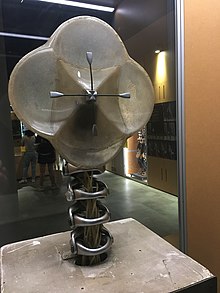Edward Ihnatowicz
Edward Ihnatowicz (born 14 February 1926, Chełm – died 1988, London) was a Polish cybernetic art sculptor active in the late 1960s and early 1970s.[1][2] His sculptures explored the interaction between his robotic works and the audience.[3][4][5]
He was a pioneer of the use of computers in art and especially robots as art. As Eduardo Kac states:[6]
...three artworks created in the mid and late sixties stand as landmarks in the development of robotic art: Nam June Paik and Shuya Abe's Robot K-456 (1964), Tom Shannon's Squat (1966), and Edward Ihnatowicz's The Senster (1969-1970). While these works are very significant in their own right, they acquire a particular meaning when re-considered today, since seen together they also configure a triangle of new aesthetic issues that has continually informed the main directions in robotic art.
He was an active member of the Computer Arts Society.
Cybernetic works
SAM

His first cybernetic work that moved directly and recognisably in response to what was going on around it was the Sound Activated Mobile (SAM).
The Senster
His most significant work was The
The Bandit
His final work of Cybernetic Art was The Bandit, which was exhibited at the
Biography
From 1939 to 1943 Ihnatowicz was a war refugee in Romania and Algiers. In 1943 he arrived in Britain and from 1945 to 1949 he attended
References
- ^ Reffin Smith, Brian (1984). Soft Computing: art and design. Addison-Wesley.
- ^ Brown, Paul (July 1996). "Emergent Behaviours towards computational aesthetics". Artlink. 16 (2 & 3): 75–83.
- ^ Zivanovic, Aleksandar (April 12–15, 2005). "The Development of a Cybernetic Sculptor: Edward Ihnatowicz and The Senster". Creativity and Cognition Conference. pp. 586–591.
- ^ Zivanovic, Aleksandar (April 13, 2005). "SAM, The Senster and The Bandit: Early Cybernetic Sculptures by Edward Ihnatowicz". Robotics, Mechatronics and Animatronics in the Creative and Entertainment Industries and Arts Symposium, AISB 2005 Convention. Hatfield, UK.
- ^ Reichardt, Jasia (May 4, 1972). "Art at large". New Scientist.
- ^ .
- ^ Reichardt, Jasia (1968). Cybernetic Serendipity: the computer and the arts. Studio International.
- ^ Reichardt, Jasia (1971). Cybernetics, Art and Ideas. Studio Vista London.
- ^ Benthall, Jonathan (1972). Science and Technology in Art Today. London: Thames and Hudson.
- ^ Reichardt, Jasia (1978). Robots: Fact, Fiction + Prediction. Thames and Hudson.
- ^
Simons, Geoff (1983). Are Computers Alive?. Brighton: Harvester. ISBN 0-7108-0501-2.
- ^ Michie, Donald; Rory Johnston (1984). The Creative Computer: Machine Intelligence and Human Knowledge. Penguin Books.
